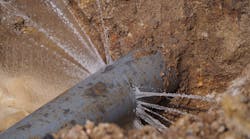The Brown County Rural Water Association (BCRWA), which serves most of Brown County, Ohio, has lowered operating costs and enhanced its finances through the installation of an automatic meter reading (AMR) system that incorporates a new generation of high accuracy water meters.
"Our operation has been steadily increasing," said Eugene Worthington, president of BCRWA. "We needed to make sure that we were recording the volume of water delivered to the customer as accurately as possible.
"Traditional methods of reading meters, coupled with the older, less efficient meters in place at the time only exacerbated the problem," he said.
The utility analyzed a number of systems during the program development phase, according to John Bender, BCRWA manager. The system had to operate in a water-filled environment and have robust components. The AMR system installed for the BCRWA included 8000 Hersey 400 Series IIStrademark 5/8 x ¾ inch Magnetic Drive Positive Displacement Disc Meters fitted with radio modules.
The Hersey 400 Series meter is ideal for measuring water consumption in today's higher usage residential applications. The meter's large positive displacement chamber provides the end-user with more water volume and less wear while measuring low flow accurately.
Radio modules are used to encode water consumption and tampering at the meter and store the data, receive a radio interrogation signal from the data collection device, and to transmit data back to the data collection device.
Other system components included handheld computers with radio transmitter/receivers, a mobile data collection unit to gather, store, and transmit water meter data, and a radio module programmer used to install, program, and investigate radio meter modules. Dedicated system software for each component also was installed as part of the package and interfaced to the existing BCRWA billing software.
"We attached the highest priority to this effort," said Marty Markalinski, BCRWA superintendent. "We were anxious to have the system up and running as quickly as possible with as little disruption and as little inconvenience to our customers as possible."
Installation of the new meters was carried out by BCRWA staff. Teams of technicians worked together, with some members moving ahead to remove old meters and install the new Hersey meters while others followed right behind, measuring the location of the meter pit and then programming each new meter. Each meter had its own identification number, helping to eliminate errors.
"In one week, we were able to install as many as 1,000 meters. That's quite an accomplishment, considering our limited resources," Markalinski said.
The implementation phase of the AMR system started with creating a standard meter reading route in the reading software, and then downloading the accounts into handheld computers with a radio transmitter/receiver. The routes started with a combination of visual and radio reads. As the routes became saturated with radio reads, the route was downloaded to the mobile data collection unit.
The mobile collection unit does not require a dedicated host vehicle — instead, it can be positioned in the front passenger seat or floor of any vehicle.
"Basically, our meter readers pass by a meter, and the transmitter sends a radio 'wake-up' call to the meter module requesting data," said Lou Naticchioni, BCRWA assistant manager. "Using radio communications, the radio meter module then transmits meter ID, reading, and tamper information back to the portable network. That means our meter readers can interrogate a meter anywhere within its off-site range."
The net effect of the Hersey AMR system installation and implementation has been immediate: more meters are being read, more accurately, and in less time. And that means the initial goals and objectives of the program — lower operating costs and enhanced revenues — already are being realized.


